When the Corvair revolutionized the American car market over 60 years ago, a host of specialized tools was needed, since much of the Corvair was quite different from other cars then available. This article overviews one particular type of tool – the jacks and cradles used to install and remove the power train. These jacks and cradles were designed and built by large tool manufacturers and were aimed at automotive professionals. They include Aerol Lift (Air Hydraulics), Ausco, Blackhawk, Fleet (Edgewater), Hein-Werner, Kent-Moore, Stephenson, Walker, Weaver, and Wudel. Most of the jacks were originally designed for “big car” transmission work.
Air Hydraulics
Air Hydraulics, Inc, of Cleveland, OH, offered one hydraulic jack for installing and removing the Corvair power train, the 18B, in their Aerol Lift line. Interestingly, while most of the other manufacturers adapted a jack design to the Corvair, Air Hydraulics promoted the Aerol Lift 18B as being designed for the Corvair but also useful for “big car” and truck transmissions by using their 100 Telescopic All-Car Adapter.
The 18B was designed for use with jack stands, had a capacity of 2000 lbs., and had a lifting range of 5 3/4″ to 45”, the widest of any of the floor jacks reviewed in this article. This jack could tilt an amazing 90° forward, as well as 10° backward, and 15° sideways (with the included 83 Tilt Adapter). Air Hydraulics sold a separate power train cradle, the 101 Corvair Motor Adapter, to interface with the Corvair power train.
The rear of the 101 cradle had a slot through which passed a captive bolt with knurled knob. This bolt and knob assembly secured the engine to the cradle by using the threaded hole in the bottom of the engine’s skid plate. Several other manufacturers also provided this handy feature with their cradles. To use this knob, of course, the factory bolt first had to be removed.
The front section of the cradle had four holes, through which bolts were inserted into the lifting pad of the 18B. The power train rested on four tangs, designed to protect the oil pan from being crushed. These tangs were present on the cradles from other manufacturers but the specific design varied, as you can see from the images throughout this article.
Air Hydraulics also sold another Corvair-specific adapter for the 18B, the 102 Corvair Bumper Adapter. This adapter could raise and lower either end of the car by using the holes in the bottom of the Corvair bumper. CPF Historian Dave Newell noted that the bumper holes were originally intended as lifting points for a roadside bumper jack but the decision was made to instead equip the cars with a sill-type jack before 1960 production started. It’s likely that the holes were also used as fixture locating points during bumper and bracket assembly in the factory.
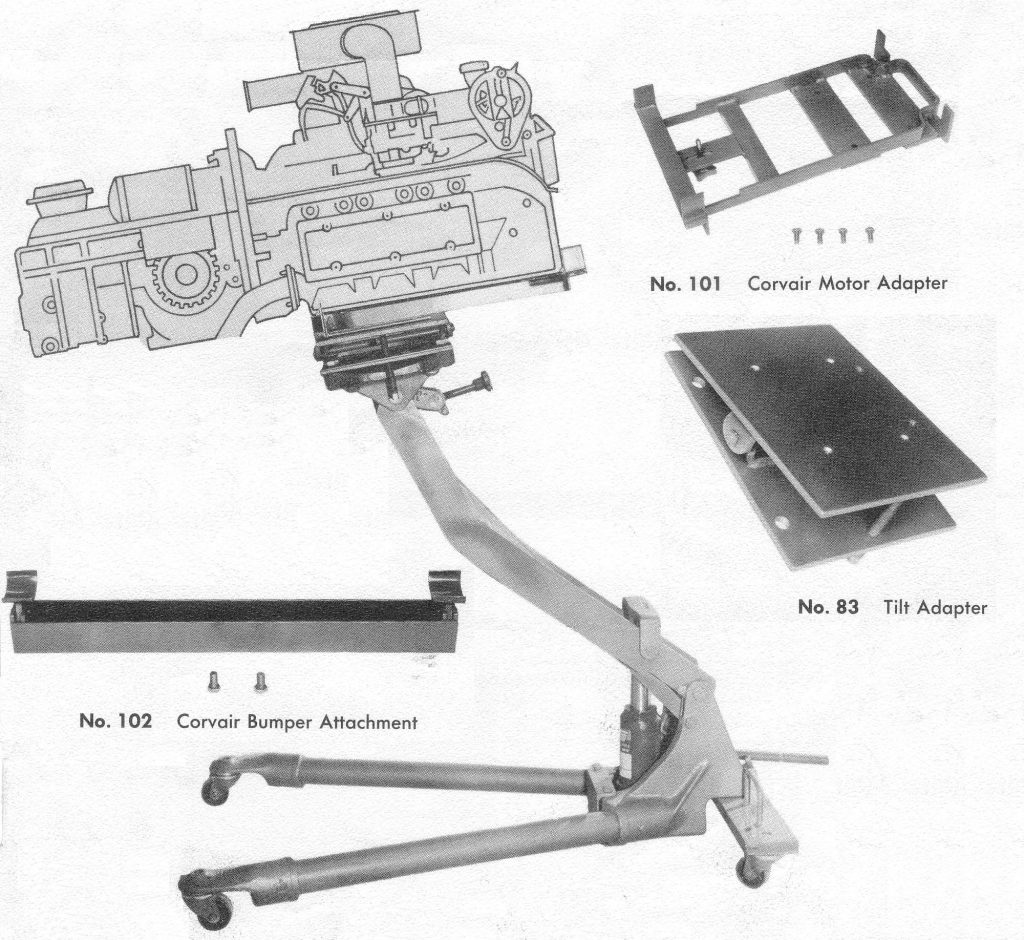
Ausco
Auto Specialties Manufacturing Co. (Ausco) of St. Joseph, MI sold two hydraulic jacks capable of installing and removing the Corvair power train. When the 1960 Corvair was introduced, their offering was the D-8200. This jack was designed to be used with a car while on jack stands. Lifting range for this jack was 9 1/8” to 33” and the capacity was 2000 lbs., with tilt angles of 37° forward, 14 1/2° backward, and 11° sideways. To mate with the Corvair power train, the new Corvair adapter (part number unknown) was required.
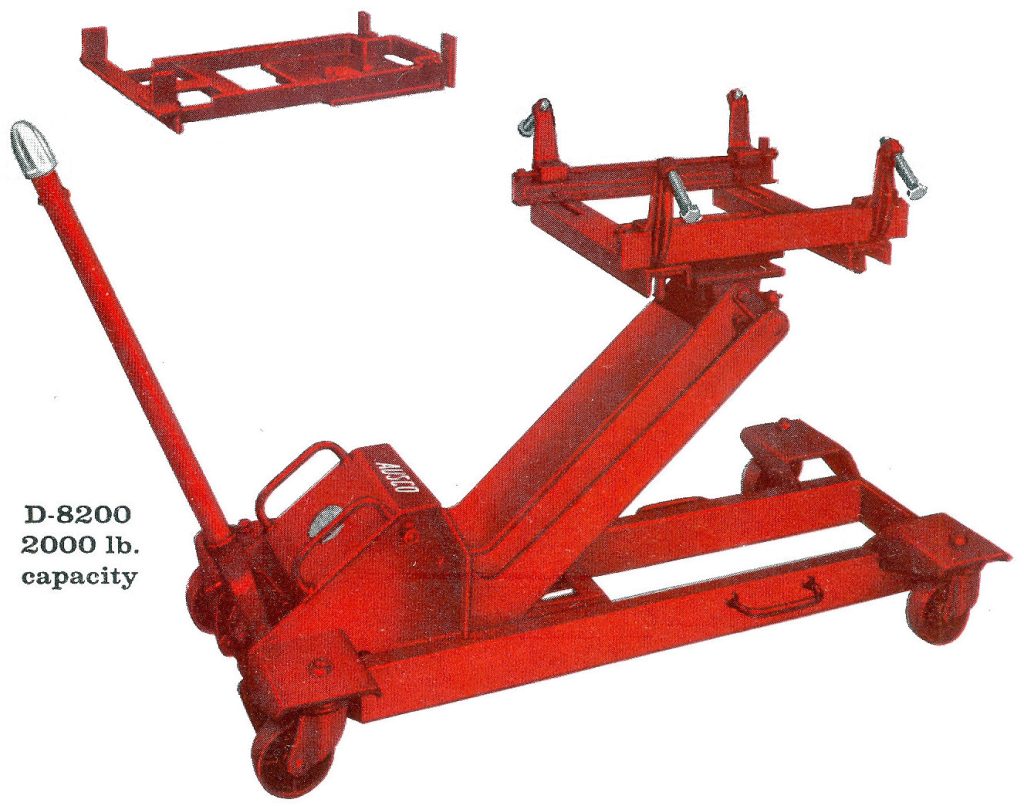
By 1962, Ausco had revised its product line and, as part of this effort, replaced the D-8200 with the A10-256. This jack was very similar to the D-8200, showing few visible differences. Like the D-8200, its capacity was 2000 lbs., but it had a slightly wider lifting range of 9 1/8” to 36”. The available literature does not list tilt angles but they were undoubtedly similar to the D-8200. The Corvair adapter was now called the Corvair Engine Adapter, A19-10029.
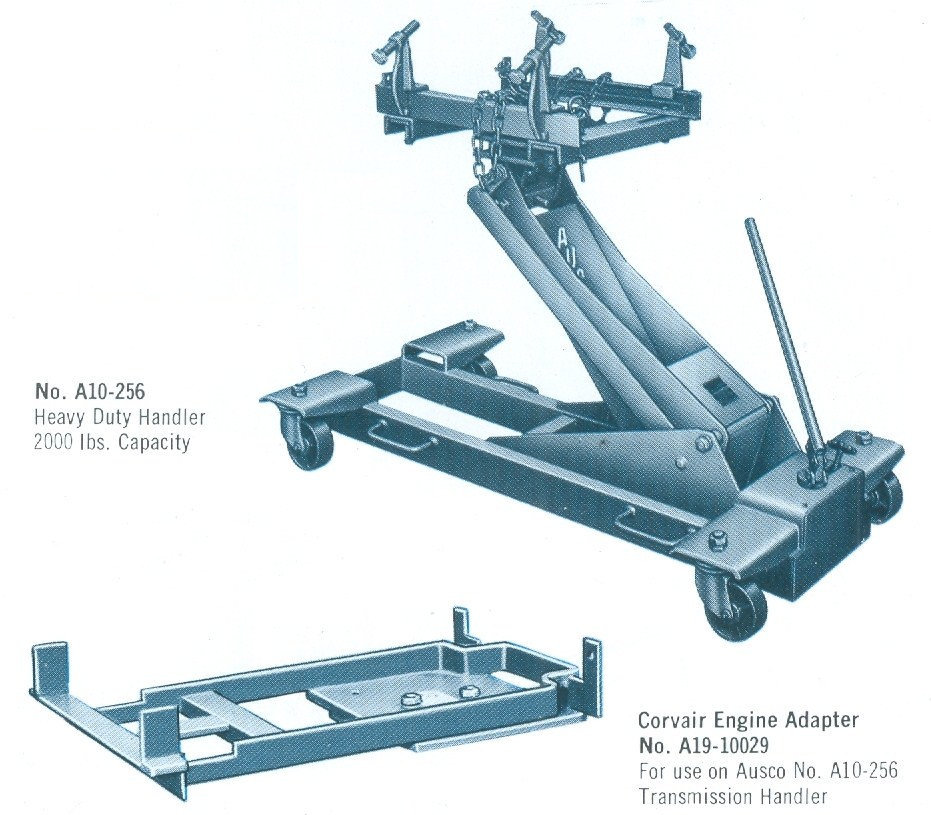
Blackhawk
The Automotive Division of Blackhawk, located in Milwaukee, WI sold three different hydraulic jacks for Corvair power train installation and removal. The T-7 was designed for use with a vehicle lift, had a capacity of 1000 lbs., a lifting range of 32″ to 37”, and could tilt 28° forward, 10° backward, and 13° sideways.
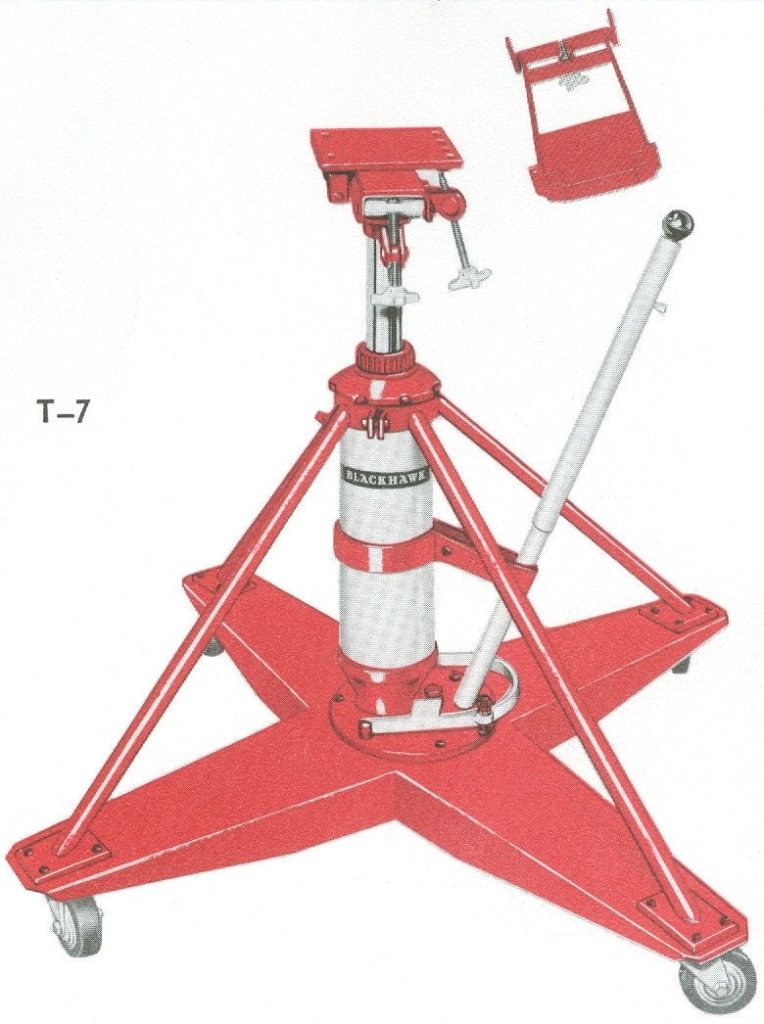
A close cousin of the T-7 was the T-2, which had been on the market before the Corvair’s introduction. Blackhawk facilitated existing T-2 owners wishing to work on Corvairs by offering a TK-20 conversion kit, which added the elements of the T-7 that were missing from the T-2. The T-2 with TK-20 had a capacity of 1000 lbs., a lifting range of 32 1/4” to 72 3/4”, and could tilt 28° forward, 10° backward, and 13° sideways. The image below highlights the TK-20 pieces on a T-2 jack.
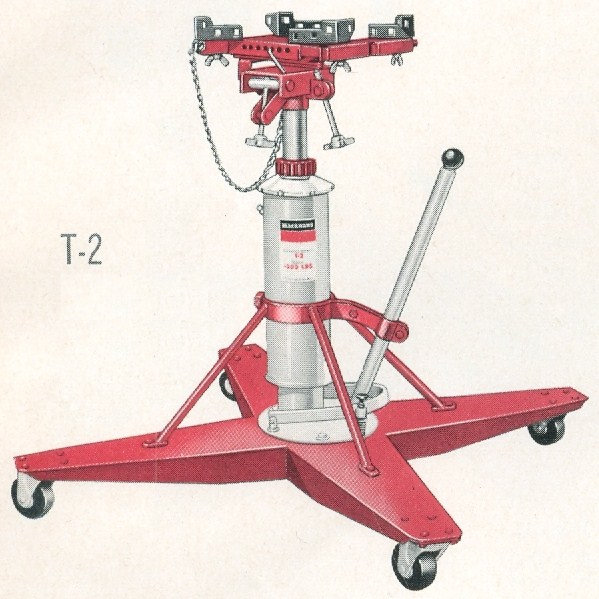
The T-1, unlike the T-2 and T-7, was designed to be used with a car while on jack stands. Lifting range for this jack was 6 1/2” to 29 3/8” and the capacity was 1000 lbs. The pump handle rotated 360° to allow operation by either hand. This jack could tilt 56° forward, 6° backward, and 12° sideways.
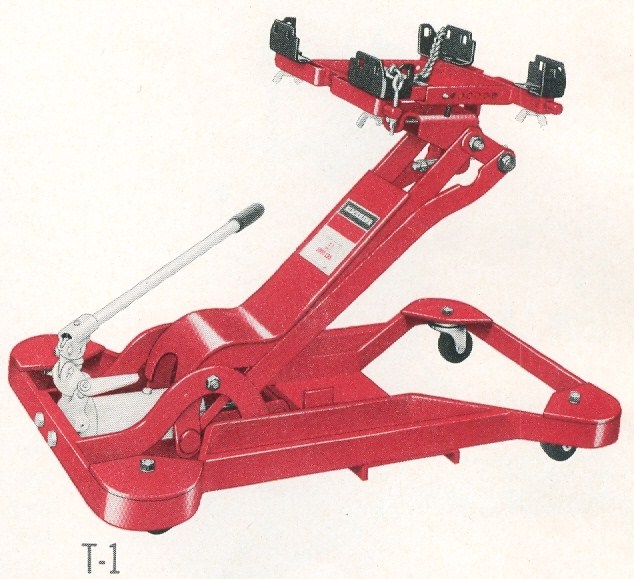
All three jacks used the TK-701 Corvair Power Train Adapter. From the Blackhawk literature, it appears that the TK-701 was sold with the T-7 and available separately for the T-1 and T-2.
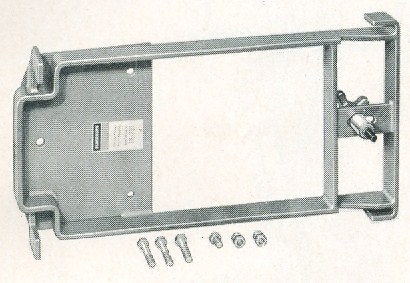
Fleet (Edgewater)
Fleet was a private label for Ausco, offered through its Edgewater Automotive Division. As such, their 5-35 jack was simply a rebranded D-8200. The same Corvair adapter (no part number) was also offered. Note: NAPA was featured in their ads as the recommended place to purchase products in the Fleet line.
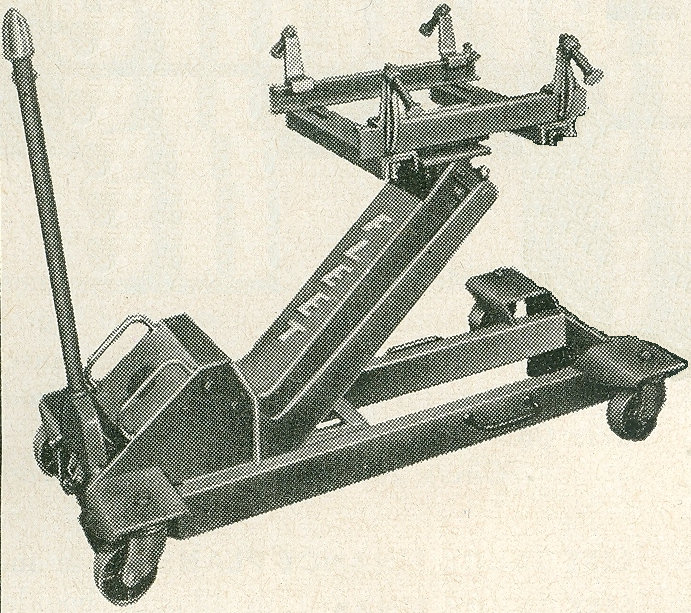
Hein-Werner
Like Blackhawk, Hein-Werner offered hydraulic jacking solutions for lift and jack stand applications. Two of their jacks were designated for use with Corvair power trains, the 54 and the 61. The 54 was designed to be used with jack stands, had a capacity of 1000 lbs., a lifting range of 6 1/4” to 31”, and could tilt 65° forward, 18° backward, and 13° sideways.
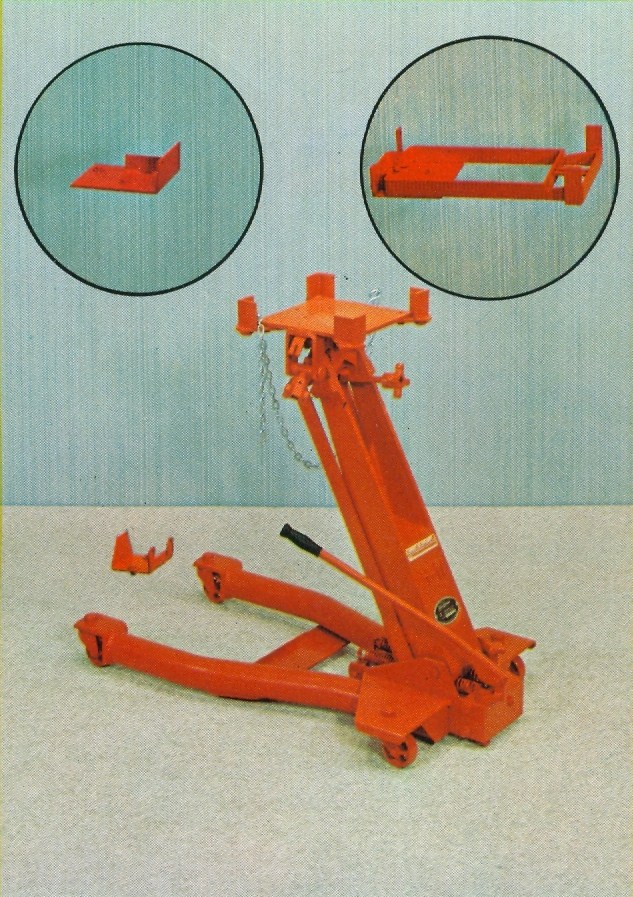
The 61 was designed for use with a lift, had a capacity of 1000 lbs., a lifting range of 31 3/4” to 75 1/2”, and could tilt 45° forward, 15° backward, and 12° sideways.
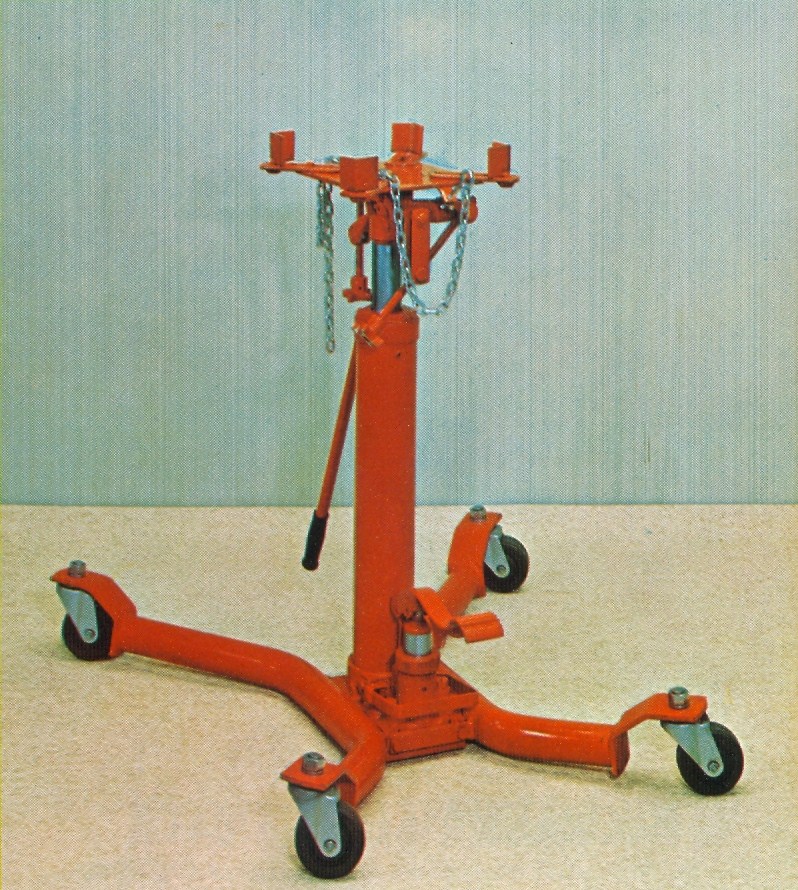
To use either of these jacks with the Corvair, the 5411 cradle was required, which is pictured with the 54 jack. This cradle appears very similar to those made by other manufacturers.
Kent-Moore
The official tool supplier to Chevrolet dealers in the ’60s was Kent-Moore, located in Warren, MI. They manufactured all of the “J-“ tools seen in the factory shop manuals. K-M designed and built a hydraulic power train jack and cradle, J-8394 and J-7894, respectively, in time for the Corvair’s launch.
The J-8394 was designed for use with a lift, had a capacity of 2000 lbs., and a lifting range of 38” to 68”. This jack had a unique tilting mechanism: A series of four long screws connecting two mounting plates allowed the cradle to move 15° forward, backward, and sideways.
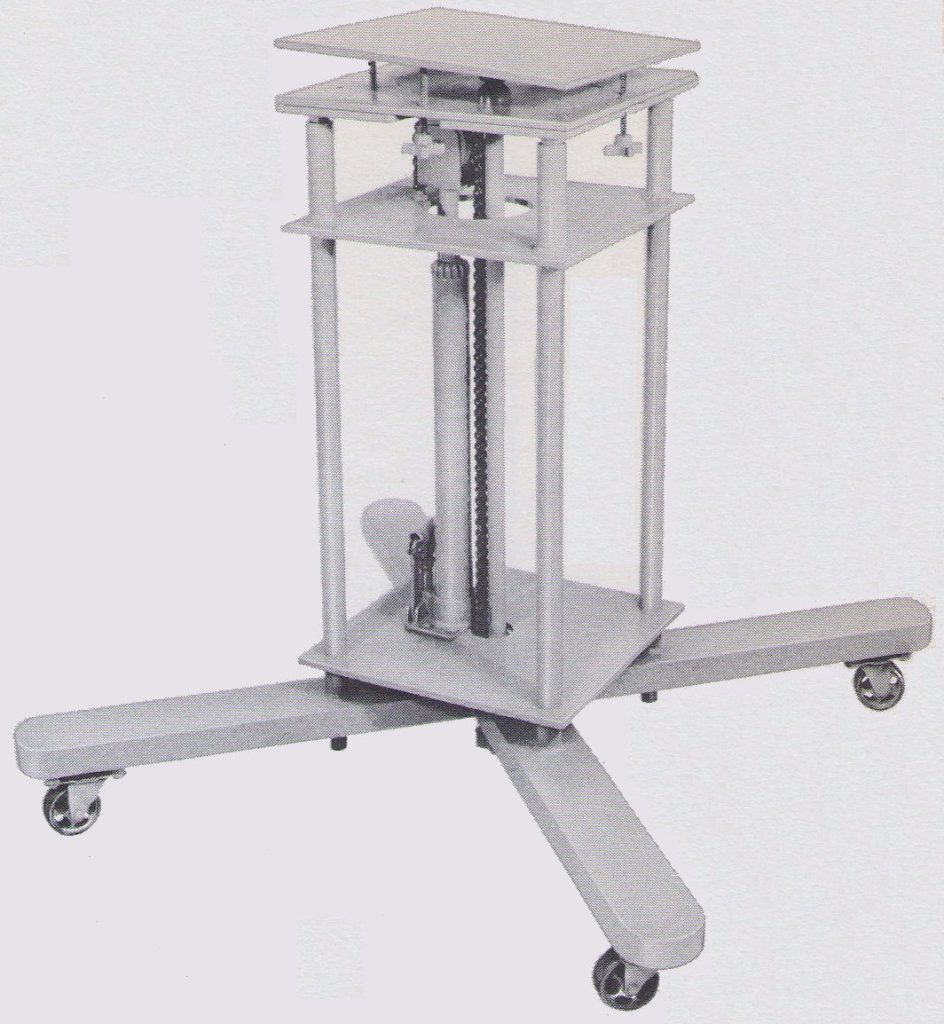
Like Air Hydraulics did with its Aerol Lift 18B, K-M promoted the J-8394 as being designed for the Corvair but useful for other auto transmissions by using other adapters they supplied.
Given that K-M was the official tool supplier for the GM, it’s likely that the J-7894 Power Train Cradle is the prototype upon which other manufacturers based their designs. Certainly, the designs were all very similar. In the picture below, a knurled-knob bolt is not shown but one was included with the cradle, based on other photos in K-M literature.
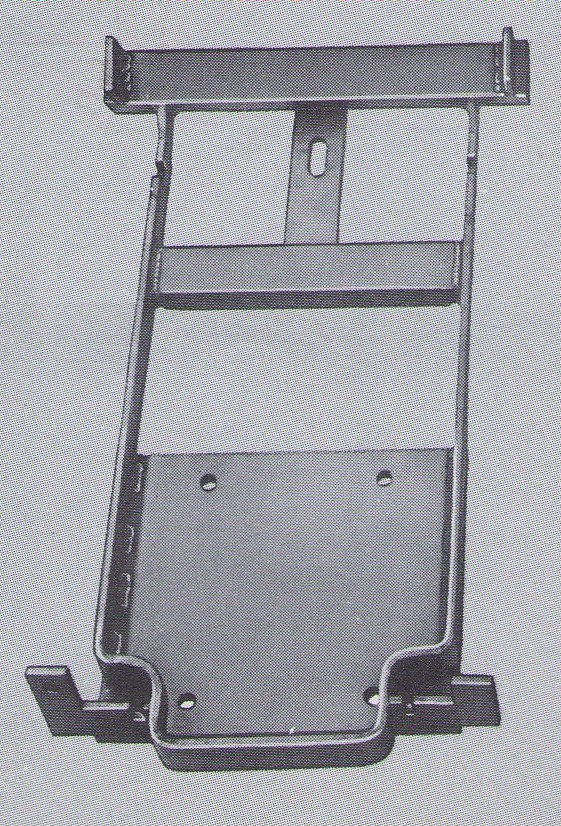
Stephenson
Stephenson Industries of Detroit, MI offered two different solutions for Corvair power train installation and removal in their hydraulic “Step-Draulic” line of jacks.
The 3250 Hi-Jack was a dead ringer for the Blackhawk T-7 described earlier. According to Bob Schwensen, owner of Universal Repair in Seattle, WA, Blackhawk made jacks for several other companies so undoubtedly that was the case here. (Universal Repair is a third-generation family-owned service company for hydraulic jacks and has a literature library going back several decades.)
The 3250, which included the 7090 heavy-duty positioning carrier (“K” in the image below), had identical specs to the T-7: designed for use with a lift, a capacity of 1000 lbs., a lifting range of 32” to 72”, and could tilt 28° forward, 10° backward, and 13° sideways.
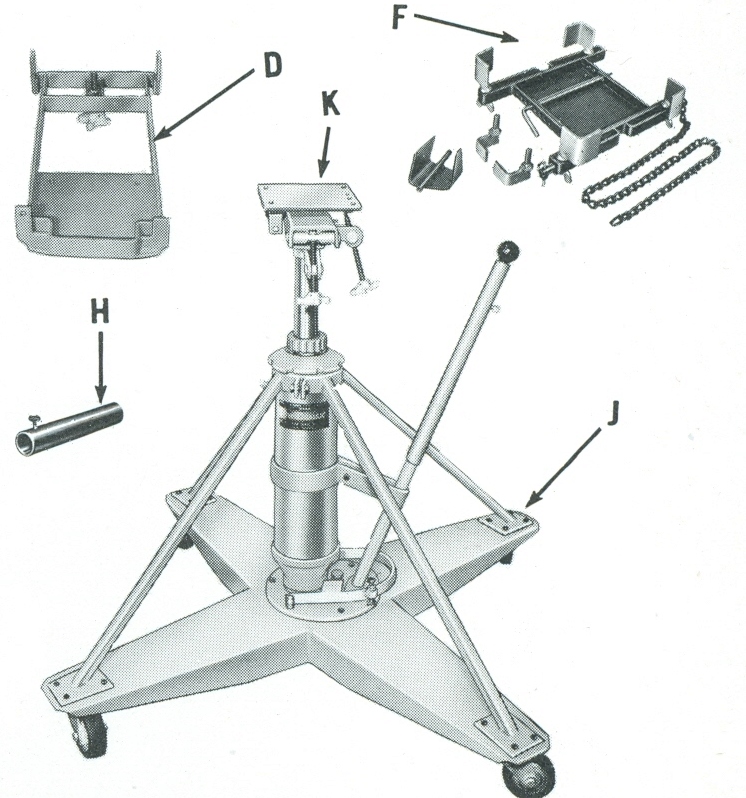
The 5500 Lo-Jack had a capacity of 2000 lbs., a lifting range of 8 1/2″ to 38”, and could tilt 45° forward, 12° backward, and 10° sideways. This jack could be used with the 5550 bumper lift adapter (“B” in the image below), to raise and lower the car for placement on jack stands.
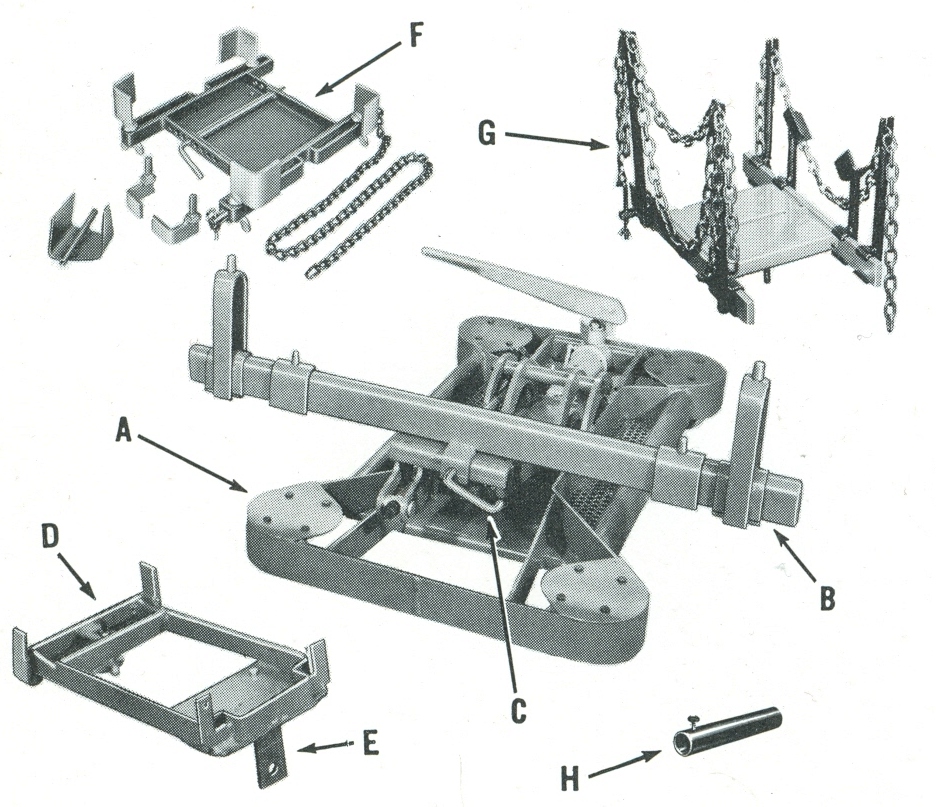
Both jacks used the 32080 Corvair Power Train Adapter to interface with the power train. This cradle was nearly identical to the K-M J-7894, and likely could interchange since the hole spacing appears to be the same. The design of the tangs is slightly different but functionally identical.
Walker
Walker Manufacturing, of Racine, WI first started selling jacks in 1912. They purchased Ajax Manufacturing in 1929 and became the largest U.S. jack manufacturer. The jack part of the business was sold some years ago to Lincoln and the muffler part of the business to Tenneco.
Walker sold three different jacks, the J-44, J-45, and J-47. The J-44, designed for jack stand operation, was unique in its gear-driven approach. The gears provided for very fine control of pitch and roll, a great help when trying to position the ungainly Corvair “Uni-Pack”. The J-44 had a lifting range of 8 3/4” to 26 3/4” and could tilt forward 75°, rearward 18°, and 10° sideways. This jack had a split capacity: 500 lbs. for lifting and 750 lbs. for positioning.
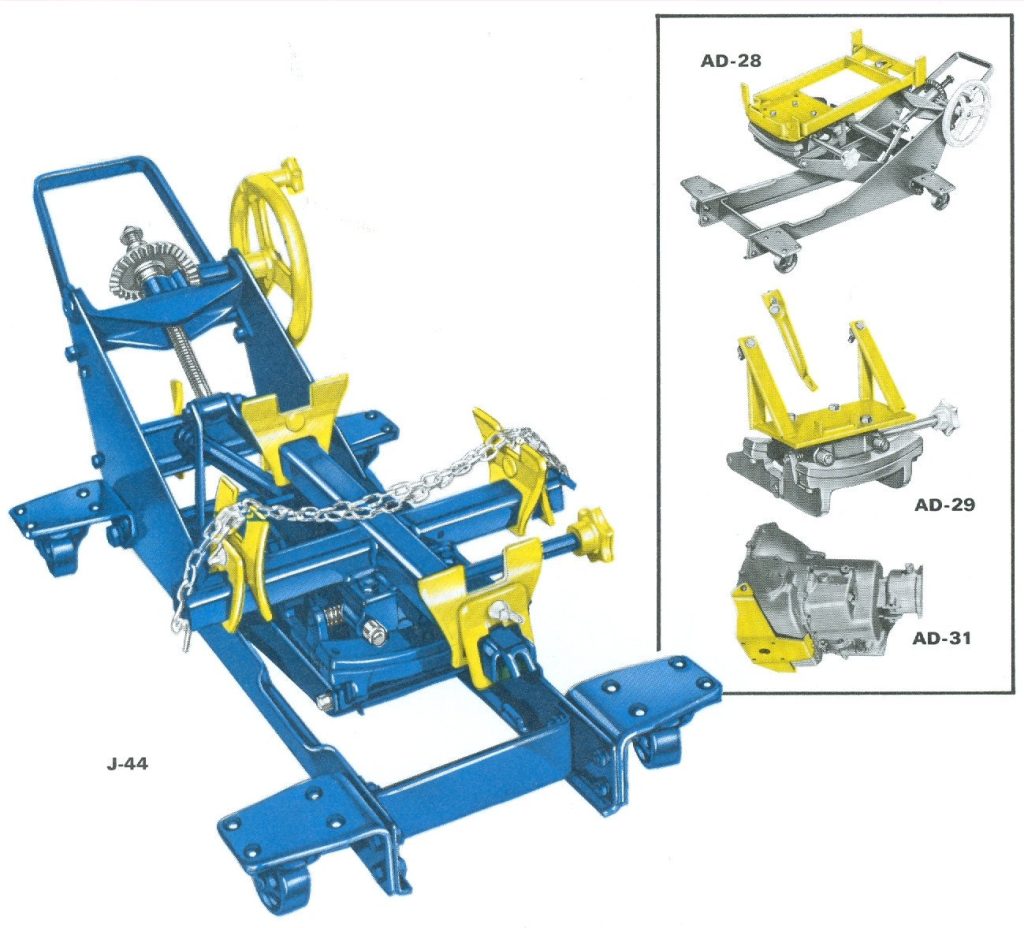
CORSA member Rich Thompson explained that the J-44 went through five revisions (A through E) and the revision level can be found on the manufacturer’s plate. “The AD-28 engine cradle was for use with series A, C, and E only. The head design changed a bit with series B and D.”
The J-45 and J-47 were hydraulic jacks. The J-45, like the J-44, was designed for on-the-floor work, had a capacity of 1000 lbs., a lifting range of 8 1/4″ to 27 1/8”, and could tilt 60° forward, 18° backward, and 12° sideways.
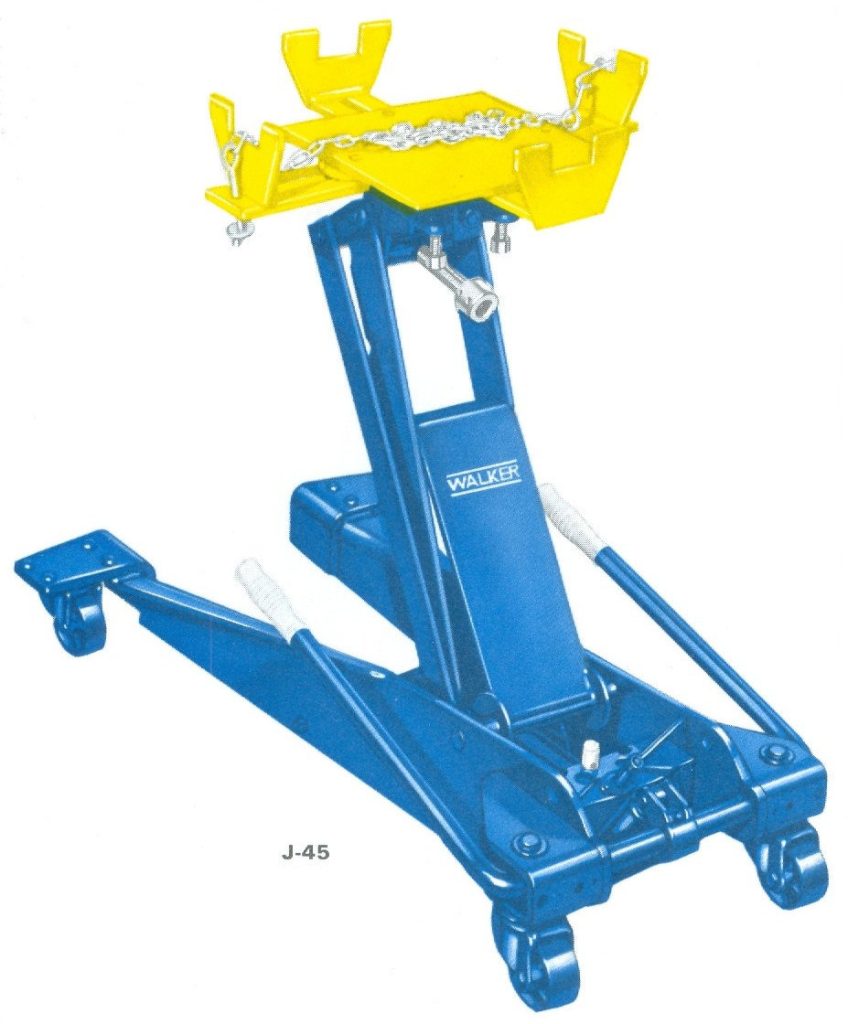
The J-47 was designed for use with a lift, had a capacity of 750 lbs., a lifting range of 38 1/2″ to 77”, and could tilt 80° forward, 18° backward, and 10° sideways. This jack required a “micro foot pedal adapter” so that finer adjustments could be made. This adapter plus the AD-28 were sold together as AD-15.

The AD-28 cradle was very similar to other manufacturers’ designs, with minor differences in the tangs. Rich commented, “The Walker cradle varied from the K-M cradle in that the rear of the cradle did not curve up like the K-M. It went out straight such that sometimes the left and right tangs rubbed up against or interfered with the thermostat doors if they were twisted or dented.”
Rich also provided this word to the wise, “The cast center gear that moves on the threaded shaft in the center of the jack is subject to damage if you do not lube it properly. You can easily strip out the threads inside the cast gear causing the jack to collapse. I had that happen to me with a powertrain sitting on it for my ’64 500 and if my hands were in the wrong place, that would have been a quick trip to the hospital. Those gears can have threaded steel inserts put into them and can be repaired at a machine shop.”
While not exactly ubiquitous, the Walker J-44 jack is much more common today than the rare Walker AD-28 cradle. I believe this is because more Walker jacks were purchased for “big car” transmission work than Corvair powertrain work. One “bonus” when buying a used Walker jack is that almost all of them come with an assortment of adapters for Ford, Chrysler, and even Studebaker & Olds Toronado transmissions, as shown in the dealer literature.
Weaver
The Weaver Manufacturing Division of Dura Corporation was located in Springfield, IL and offered the WA-140 two-stage hydraulic transmission jack and WA-142 Corvair engine cradle. The jack had a capacity of 1000 lbs., a lifting range of 34 1/2” to 77 1/2″, and could tilt 25° forward, 10° backward, and 12° sideways. The lifting pad could also be slid up to 3 1/2″ side-to-side, apparently a unique feature among the solutions reviewed in this article.
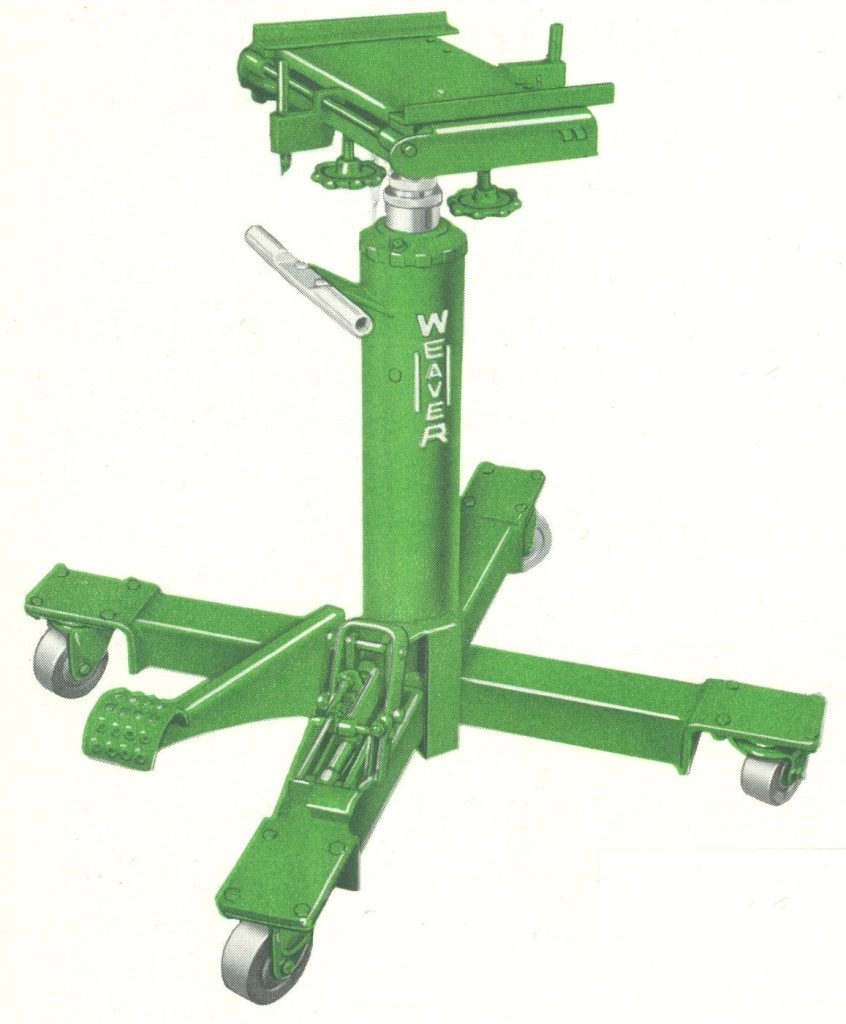
The WA-142 cradle was very similar to the other cradles discussed, with minor differences in the tangs.
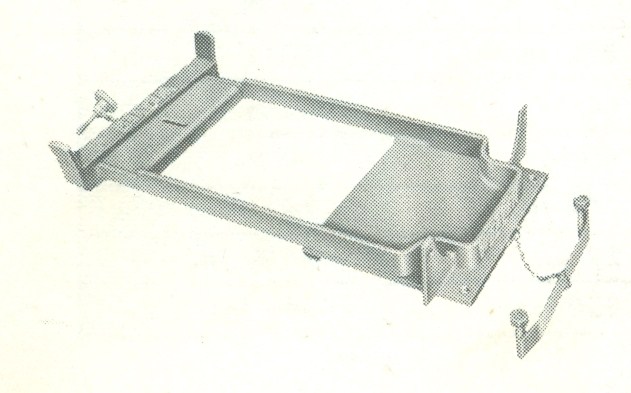
Wudel
The Edward J. Wudel Manufacturing Company, located in Los Angeles, CA offered two different solutions for Corvair power train installation and removal. The 711 two-stage hydraulic jack was designed for use with a vehicle lift, had a capacity of 1000 lbs., a lifting range of 32” to 72”, and could tilt 80° forward, 20° backward, and 22° sideways.
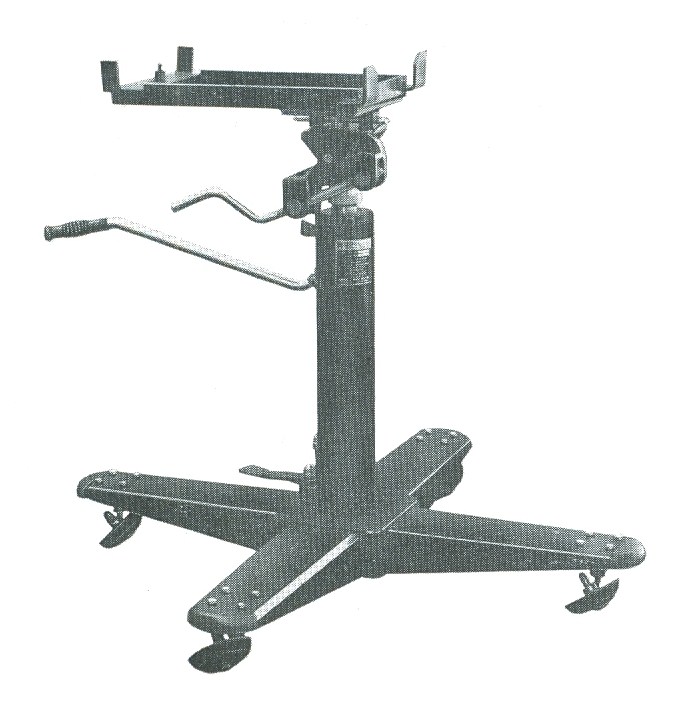
The 700 was designed to be used with jack stands, had a capacity of 1000 lbs., a lifting range of 7 1/2” to 32”, and could tilt 90° forward, 8° backward, and 22° sideways.
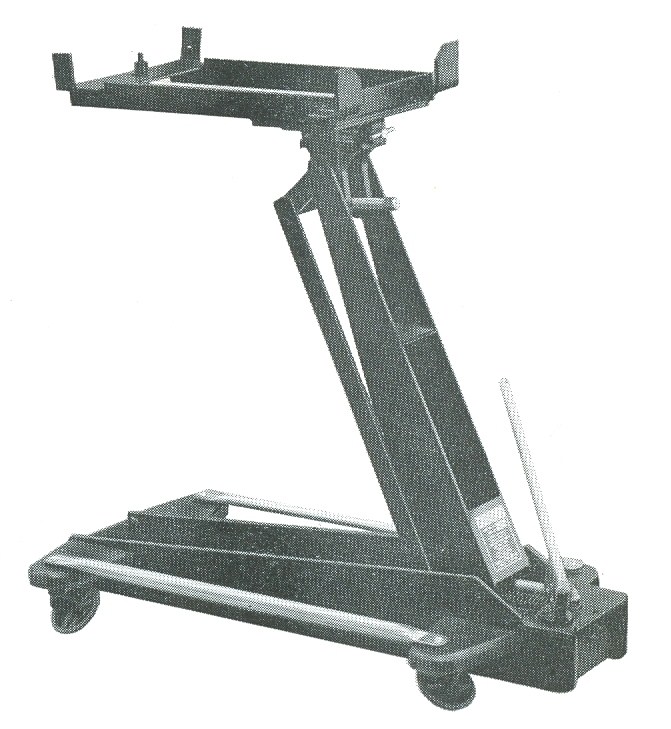
Both jacks used the 57C Corvair Engine Adapter to interface with the power train. For some period of time, Wudel packaged the 700 jack with the 57C cradle as the 700C. Wudel also sold the 56 K-M Adapter Plate to allow the K-M J-7894 cradle to be used instead.
Wudel offered a further convenience with two engine stands designed for holding the power train once removed. The 58 stand was designed for use with the 700 jack and held the power train at a 30” height while the 58-1 stand was designed for use with the 711 jack and held it at a slightly-higher 35” height, necessary due to higher minimum lift height of this jack. These stands featured a portable arm on the side of the frame, which could be locked into a parallel position on either end of the engine so that items could be removed at either end, such as the bell housing. Either stand also had an open underside to allow the oil pan to be removed. Wudel also recommended use of the 50 Universal Adapter for adjusting the position of the power train while on the stand.
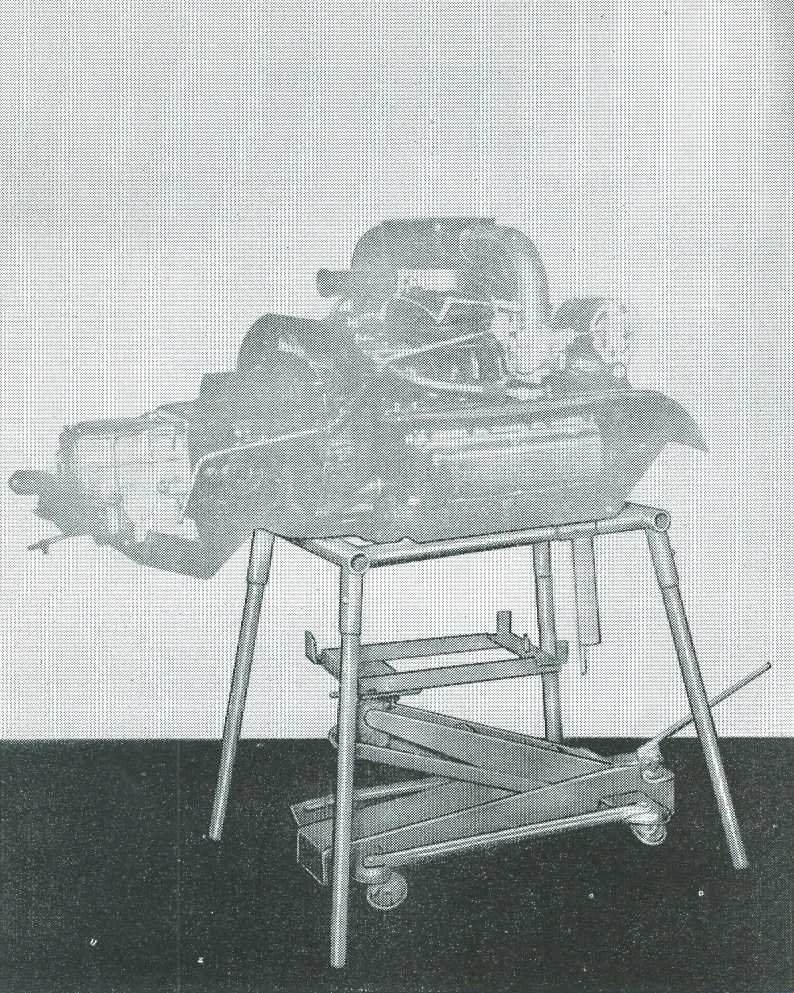
In later years, Wudel also sold the 70 stand for use with the 700 jack. This stand was designed for the 700 jack to sit on it and therefore add enough additional height to be usable with a vehicle lift. The stand was adjustable to provide 42”, 44 1/2″, or 47” of additional height.
Floor Jack Summary
| Manufacturer | Model | Capacity (lbs.) | Minimum lift height | Maximum lift height | Forward tilt | Backward tilt | Sideways tilt |
| Air Hydraulics | 18B | 2000 | 5 3/4″ | 45” | 90° | 10° | 15° |
| Ausco | D-8200 | 2000 | 9 1/8” | 33” | 37° | 14 1/2° | 11° |
| A10-256 | 2000 | 9 1/8” | 36” | ? | ? | ? | |
| Blackhawk | T-1 | 1000 | 6 1/2″ | 29 3/8” | 56° | 6° | 12° |
| Fleet | 5-35 | 2000 | 9 1/8” | 33” | 37° | 14 1/2° | 11° |
| Hein-Werner | 54 | 1000 | 6 1/4″ | 31” | 65° | 18° | 13° |
| Stephenson | 5500 | 2000 | 8 1/2″ | 38” | 45° | 12° | 10° |
| Walker | J-44 | 500/750 | 8 3/4″ | 26 3/4″ | 75° | 18° | 10° |
| J-45 | 1000 | 8 1/4″ | 27 1/8″ | 60° | 18° | 12° | |
| Wudel | 700 | 1000 | 7 1/2″ | 32” | 90° | 8° | 22° |
Lift Jack Summary
| Manufacturer | Model | Capacity (lbs.) | Minimum lift height | Maximum lift height | Forward tilt | Backward tilt | Sideways tilt |
| Blackhawk | T-2 | 1000 | 32 1/4″ | 72 3/4″ | 28° | 10° | 13° |
| T-7 | 1000 | 32” | 72” | 28° | 10° | 13° | |
| Hein-Werner | 61 | 1000 | 31 3/4″ | 75 1/2″ | 45° | 15° | 12° |
| Kent-Moore | J-8394 | 2000 | 38” | 68” | 15° | 15° | 15° |
| Stephenson | 3250 | 1000 | 32” | 72” | 28° | 10° | 13° |
| Walker | J-47 | 750 | 38 1/2″ | 77” | 80° | 18° | 10° |
| Weaver | WA-140 | 1000 | 34 1/2″ | 77 1/2″ | 25° | 10° | 12° |
| Wudel | 711 | 1000 | 32” | 72” | 80° | 20° | 22° |
Conclusion and an Invitation
I hope you have found this overview of commercial Corvair power train jacks and cradles interesting. I certainly had no idea how many different options existed when I started this research. Please help continue the conversation by posting comments and pictures about jacks and cradles you have owned or used below.
Postscript: Tools created after the Corvair’s production run
The following jacks and cradles were designed and built by Corvair aftermarket vendors and individuals and were aimed at automotive hobbyists. Many of them don’t have official names so I have taken the liberty of using the creator’s last name in those cases. If you know of any, please post in Comments.
Clark’s Corvair Parts
Little is know at this time about who created the 4-wheel low-profile stand with removable cradle that Clark’s Corvair Parts sold for a number of years. CORSA member Bill Hubbell shared a picture of his.
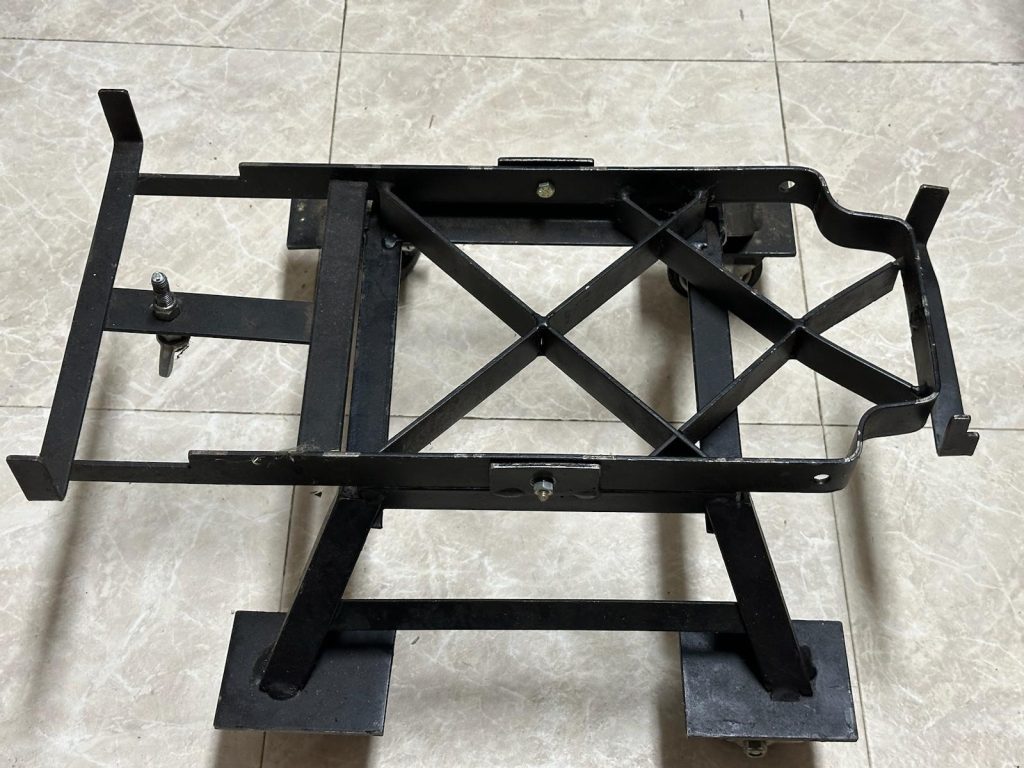
Finch
Richard Finch, in his classic How to Keep Your Corvair Alive, explains how to build a cart that, when used in conjunction with a floor jack, provides much of the same functionality as the commercial cradles. However, the Finch device is definitely a cart and not a cradle. Zoltan Szilagyi, one of many CORSA members who has built and used a Finch cart successfully, commented, “For powertrain removal, you lower the car so that the powertrain rests on the cart, then disconnect the powertrain’s mounts, then raise the car, leaving the powertrain in place on the cart; installation is the reverse. There is never a jack under the powertrain; lifting devices are only used on the car body.”
The “Finch cart” has been successfully used by Corvair mechanics for many years and is elegant in its simplicity—just a few 2”x4” sections, some wood screws, and some casters. Zoltan commented, “The Finch cart is by far the easiest and cheapest cradle to construct, it is straightforward to use, and it feels secure and predictable since most of us have a lot more practice jacking the car than jacking the powertrain. Therefore, it’s a great match for the typical home mechanic who’s working with a lift. Also, with its six wheels, it’s also quite functional as a way to smoothly roll the engine around once it’s out of the car. I’m not sure if the other jacks are quite as mobile.”
One common modification is to move the divider forward to better accommodate longer and deeper aftermarket oil pans.
F&N Enterprises
Gary Fricke, of Van Nuys, CA, designed and manufactured two Corvair powertrain cradle in the ’80s. The “post-style” cradle was designed for use with floor jacks that had removable lifting cups. The “universal style” cradle was designed for floor jacks with non-removable lifting cups. This cradle clamped over the cup. Some CORSA members in my area purchased the “post-style” cradle at the 1983 CORSA convention in Seattle and they are still using them today.
This cradle had several design innovations, including tall sides to accommodate deep aftermarket oil pans, adjustable pivot point to compensate for different powertrain balance points due to heavier or lighter components, scalloped front edge to make more contact with the bellhousing than the tangs used in the Walker et al. cradles, and a “finger” that fits into a recess on the driver’s side of the bellhousing, providing even more stability when moving the powertrain than the commercial cradles from Walker et al. Fricke also let the customer specify the post diameter for the “post-style” cradle.
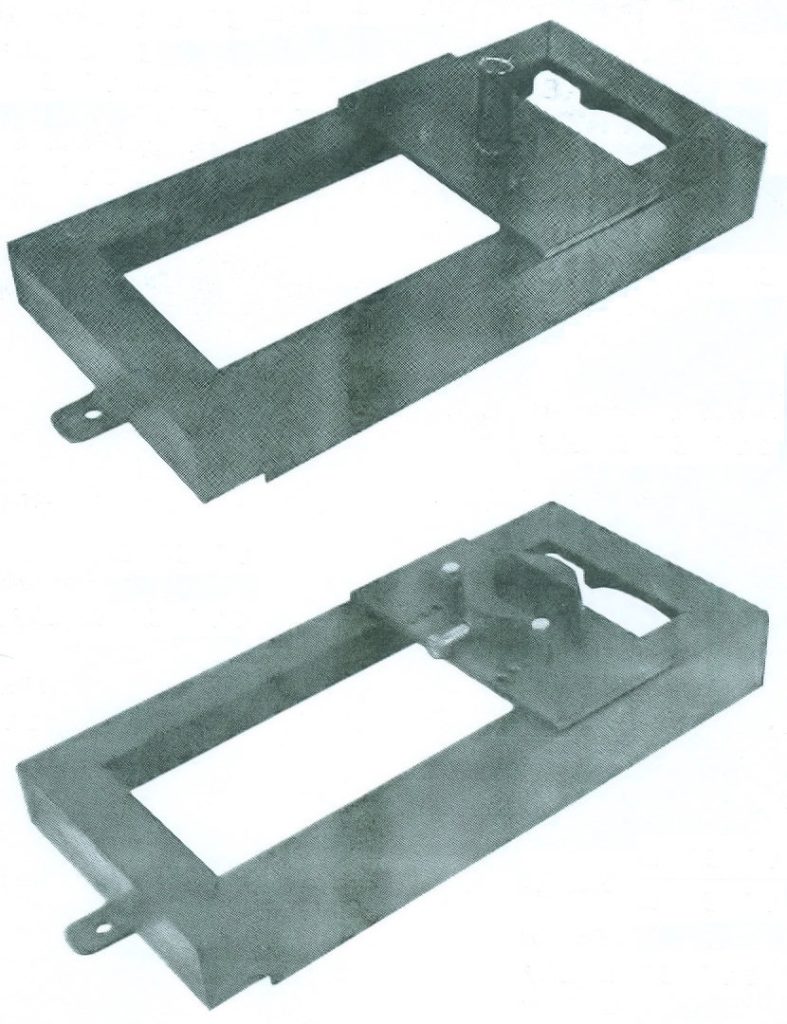
Luckow
Recently, CORSA members Charlie Garthwaite, Joel Rushworth, and I worked with Duanne Luckow to iterate on the Fricke design. The most important change was making the jack post removable so that the cradle can be used with a floor jack or a Walker jack, which solved the problem I mentioned earlier of trying to locate a rare Walker original cradle. Duanne also made post assemblies in both 1” and 1 1/8” diameters to accommodate a wide variety of floor jacks.
Another important change was shortening the height of the cradle by using 2” x 2” angle iron rather than 2” x 3”. This dramatically reduced the weight of the cradle while still allowing it to work with most aftermarket oil pans. We were willing to give up compatibility with super-deep pans on buggies and some FCs. We also made the bellhousing “finger” removable, which allowed the bolt in that location to be removed at the mechanic’s convenience. We also created an access slot in the side to be able to remove the finger with the cradle mounted on an engine. During manufacturing, Duanne added gussets to the front corners for added strength.
Finally, we added relief slots in sides to clear the heads of the heater box screws, so that they don’t have to be removed. As a final touch, we powder coated the cradle rather than painted it, for durability.
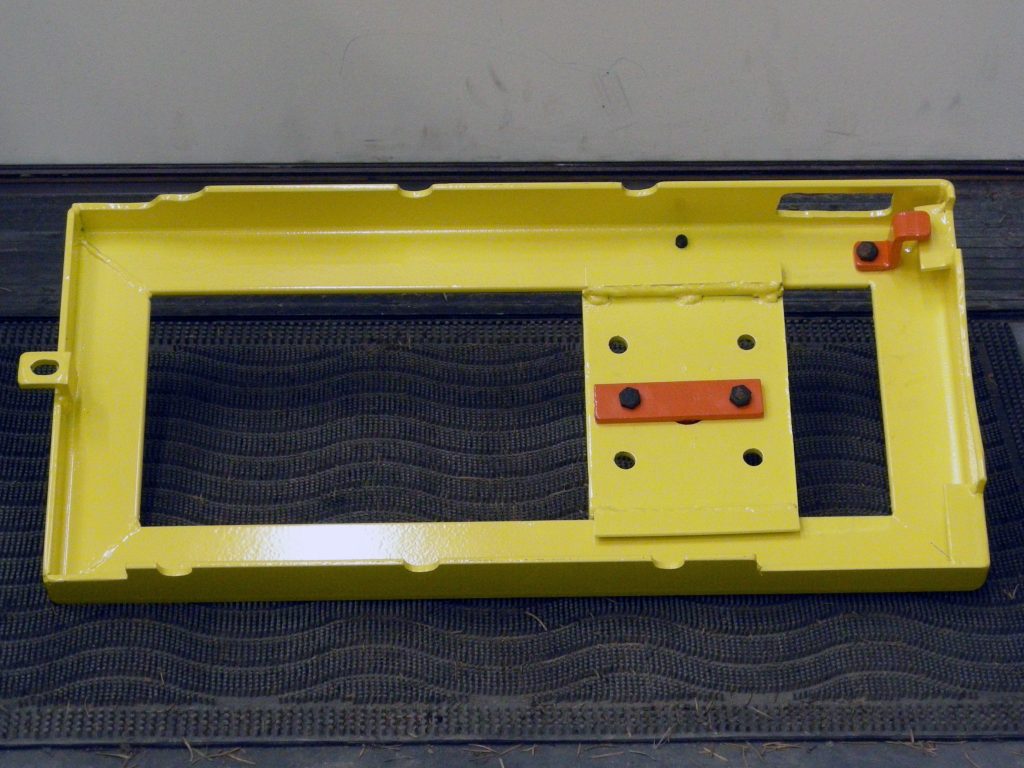
Monasterio
Daniel Monasterio, a CORSA member from Guadalajara, Jalisco, Mexico, fabricated a cradle of his own design in 2008. His cradle is designed to be used with a floor jack, and has a couple of important innovations. First, the design is very straightforward, such that basic metalworking tools can be used to create it in a home shop. Second, the cradle hugs the inside lip of the oil pan, providing support along its entire perimeter without interfering with the oil pan bolts or heater box screws.
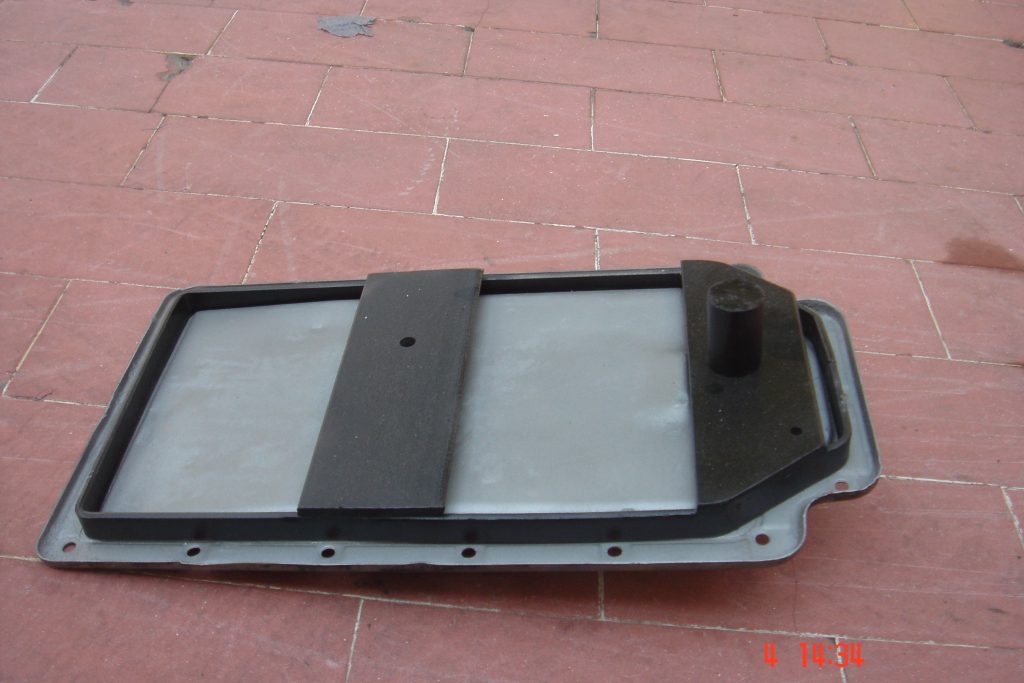
Watson
CORSA member Dave Watson designed a cradle patterned after one his father, a GM mechanic who was the Corvair specialist, used on the job. Dave created a number of prototypes, with the goal of being able to work with every oil pan, regardless of how deep.
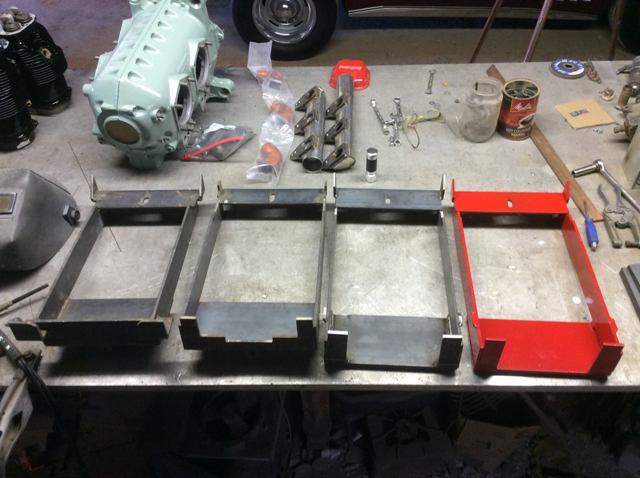
Dave’s solution was immediately in demand so he undertook manufacturing a batch of 60 of them, which turned into regular production runs over the past 16 years, using laser cutting and machine bending for fewer welds and more strength.
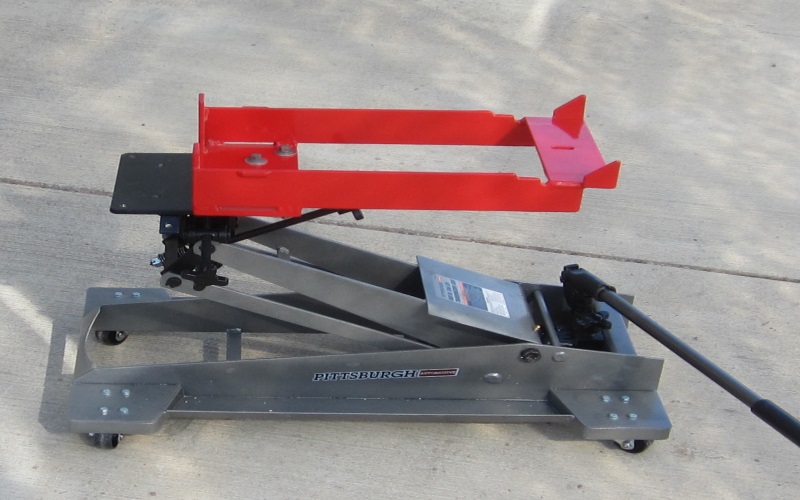
Dave also sold a few powertrain stands, patterned again after the setup his dad had.
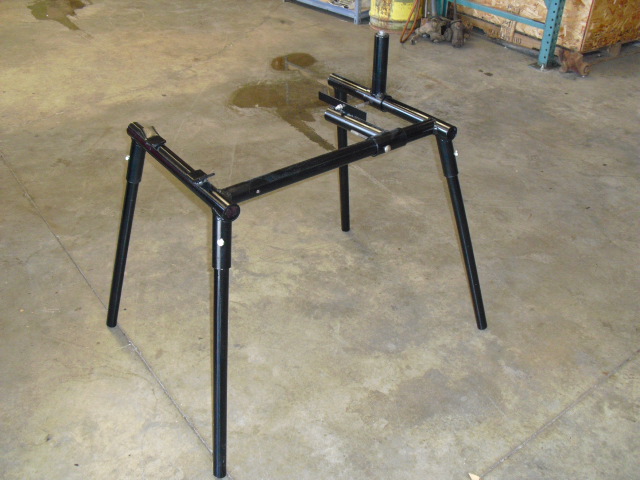
The center arms let you remove either the bell housing end or the oil pump end without removing the engine from the stand for servicing. For example, when you remove the motor mount bracket, the arm swings in and then the engine is supported to remove the oil pump housing.
Other approaches
A very common solution among Corvair mechanics is to use a readily available, relatively inexpensive All-Terrain Vehicle (ATV) jack, in conjunction with some sort of fabricated cradle. To use an ATV lift, some sort of cradle is needed. CORSA member Larry Forman created a slightly narrower Finch cart, so that the sides rested securely on the ATV lift’s arms. Larry reported that this worked fine, but that the wood tended to get chewed up when sliding the powertrain off the lift. Larry then designed a metal cradle that is reminiscent of many of the cradles discussed earlier in this article.



